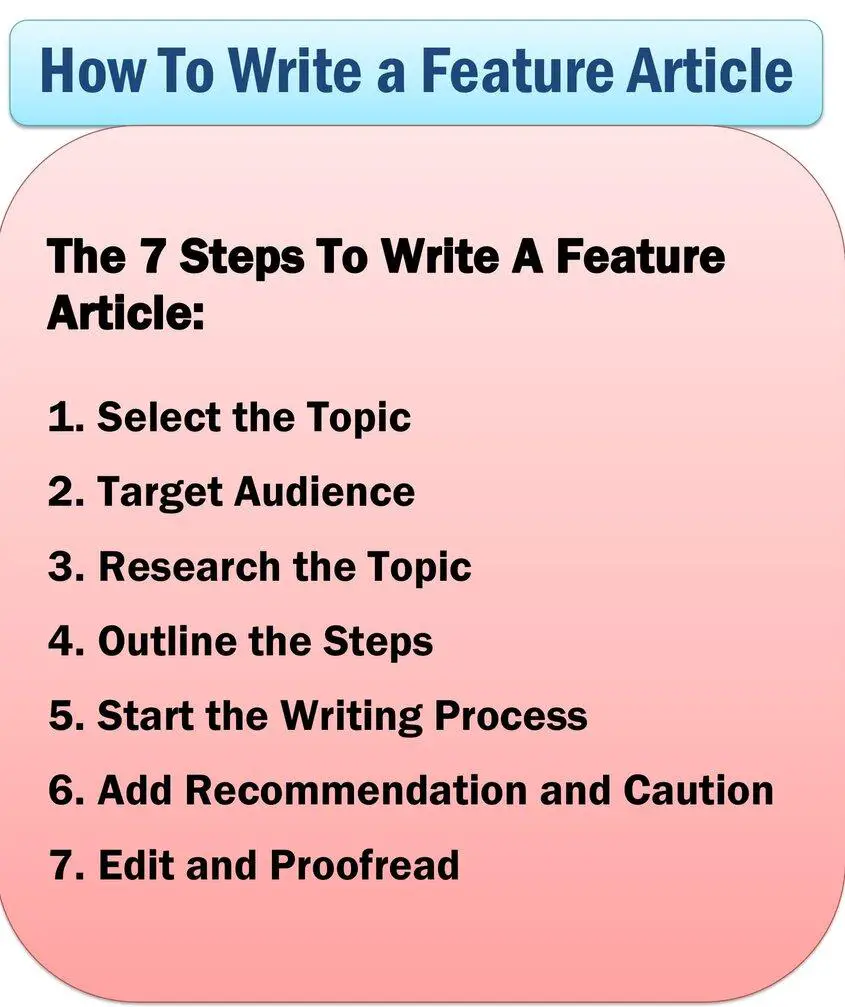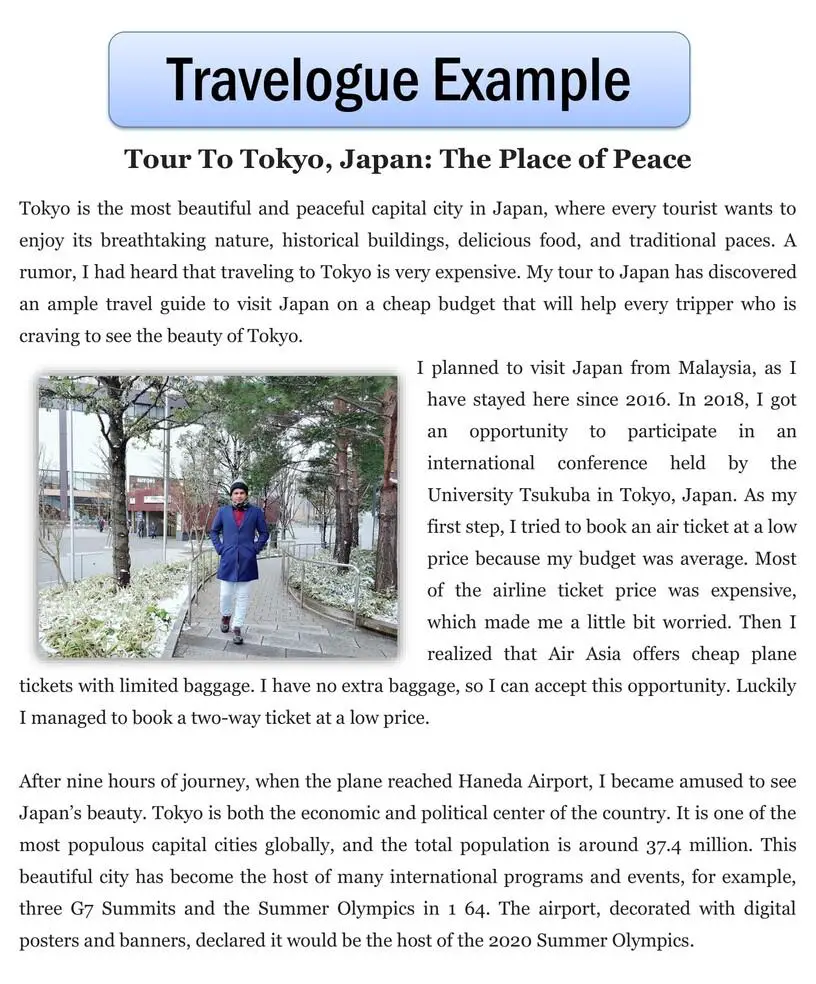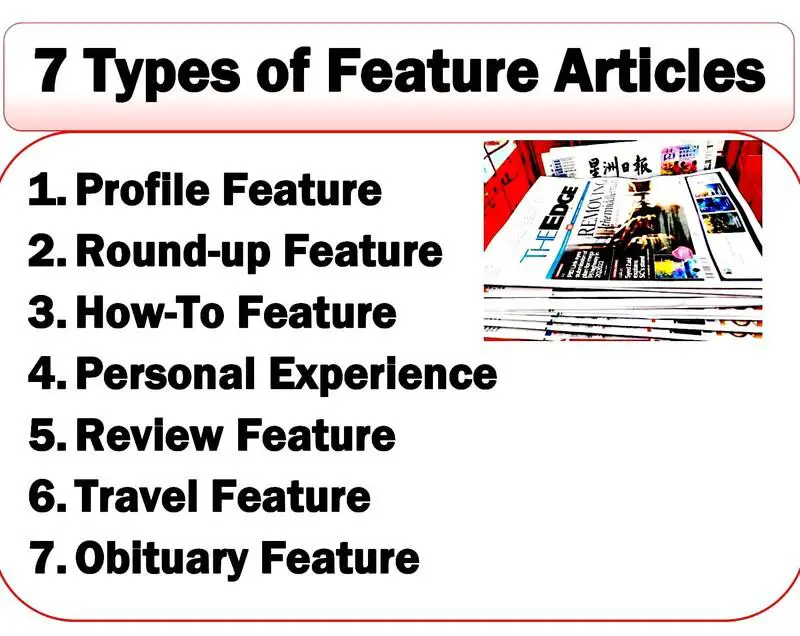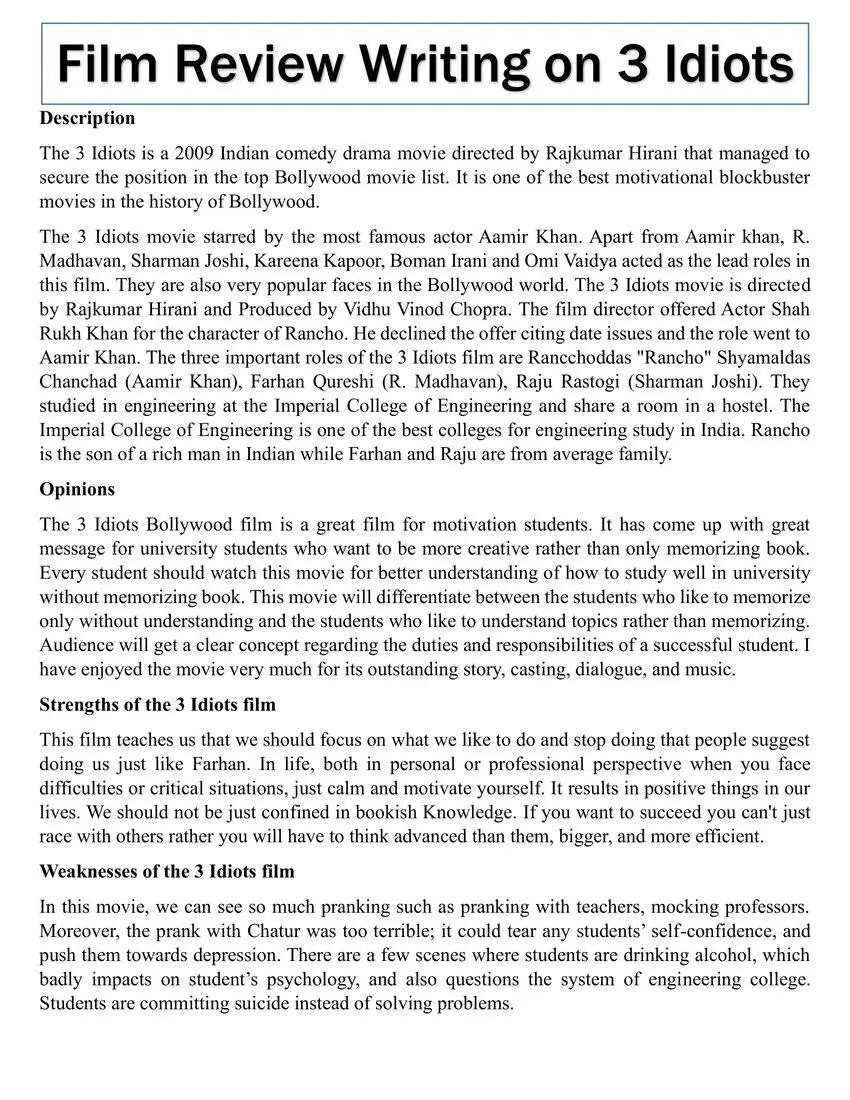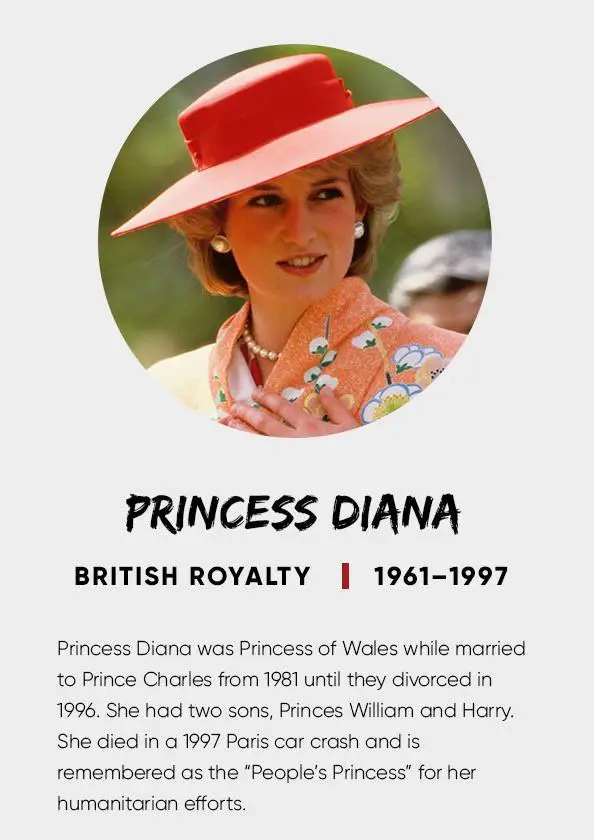Feature Articles Examples for Students PDF. Feature Writing Example For Students. How to Write a Feature Story.
Feature Article
A feature article refers to the human-interest story in mass media, including newspapers, magazines, blogs, and websites. It is a journalistic report but not opinion or editorial writing. The fundamental objective of the feature articles is to educate and entertain people, concentrating on certain people, locations, events, and expertise. For example, a travel feature article focuses on a particular location and describes why tourists should visit the place. The profile feature article also represents a person's lifestyle, hobby, profession, recognition, and goal. There are many types of feature articles. The seven most common feature articles in journalism are profile, travel, round-up, how-to, personal experience, review, and obituary.
The feature article is soft news, so writers take enough time to study the topic to publish it. Journalists research, gather information and convey a descriptive and meaningful message through feature articles about the original ideas. However, journalists intend to publish hard news quickly in print media. Hard news cannot adequately explain the event's background due to the lack of preparation and time.
How Long Should a Feature Article Be?
- A feature article should be 500 to 2500 words in length for newspapers.
- A feature article should be 500 to 5000 words in length for Magazine.
Feature Articles Examples for Students
Today, the author explains how to write a feature article for students in journalism. This article also mentions seven steps to writing feature stories. The writers must prepare before writing the feature article and follow the steps thoroughly to yield a thoughtful article.
The Steps To Write a Feature Article
The seven steps to writing a feature article are as follows:
- Select the Topic
- Target Audience
- Research the Topic
- Outline the Steps
- Start the Writing Process
- Propose Recommendation and Caution
- Edit and Proofread
1. Select the Topic
Firstly, the writers have to select the subject topic in which they can generate a meaningful feature article. It is significant to set a title as part of the pre-writing article. So, the author suggests the writers choose a topic they are interested in studying. Additionally, the writers must have a good idea and experience with the topics. For example, if the writers like to travel to tourist areas and know how to describe a tourist place. It will undoubtedly help them to set the feature article's topic based on travel experiences. Therefore, selecting a topic is a crucial and initial step in writing a feature article in journalism.
2. Target Audience
Target audience is the second stage of making a feature article. It is another essential fact; it is useless if nobody reads the story. For example, the youths show more interest in topics related to social media. In contrast, they might offer less interest in the feature article relevant to cooking recipes. However, the restaurant owners and cooks show more interest in cooking instructions. So, the writer must set the topic based on the target audiences who will read the articles. The researchers suggest following geographic, demographic, and psychographic factors when targeting the audiences.
3. Research the Topic
Research on the topic means studying the issue in depth to collect more information. So, writers should take enough time to research the case before writing the feature article. It isn't easy to write a thoughtful story without providing precious information. The research assists journalists in discovering sources. Authentic sources help verify information authentication, such as statistic reports, quotes by a well-known person, and references from TV, newspapers, radio, and journals. Hence, research on the topic is significant in making the article more valuable and believable.
4. Outline the Steps
The outline of the steps means sketching all stages that the writer plans to complete thoroughly. The writers should make a rough draft of how to write a complete feature story mentioning all steps of feature writing. This outline certainly helps to determine how many steps writers need to complete and how many have already been done. It also discovers the strengths and weaknesses of the writers. So they can take the additional initiative to overcome weaknesses. The best way to outline the stages is by using transitional verbs or highlighting points with number sequences. After all, it has appeared as an essential step in feature writing.
5. Start the Writing Process
The writers start to write the feature article in this stage. Therefore, it is the most significant part of feature writing. In the first paragraph, they should introduce the feature so readers can understand the topic's essence. In addition, journalists explain the advantages of reading this article; therefore, they use catchy sentences to attract audiences. For example, journalists must explain what kind of adverse consequences the audience can encounter by hacking if they want to write a feature article about how to stop hacking Facebook IDs. So it triggers them to read the full article.
Moreover, the researcher suggests writing one paragraph for each section and never messing up one part with other parts. The writer should remember that readers are not aware of the writing process. So, it will be difficult for them if they do not write one paragraph in each section. For example, journalists should mention "how to open a Facebook ID" before instructing them to protect Facebook from hacking.
Furthermore, the writers should use chronological order to clarify every step to the readers. For example, they should mention steps one, two, and three of the article for better understanding. They also need to use action verbs to describe steps, such as apply, write, cut, mix, use, change, etc.
Finally, the writers should ensure that the article is simple and friendly. So, they need to stop using irrelevant information and make it assertive.
6. Add Recommendations and Caution
If necessary, the journalists should propose suggestions and cautions when necessary. The readers might consider the writer less informative if they do not offer recommendations. It is a fundamental duty to add a warning if there have any possible dangers in the process of the article. For example, the writers suggest wearing winter dresses to keep warm when writing the travelogue feature article representing cold places, including Antarctica, Russia, Iceland, Canada, and the United States.
7. Edit and Proofread
The final step of feature writing is editing and proofreading. It means revising the article again and again before publishing it for the readers. The writers should read the article loudly in front of friends and employees to verify it. They need to brainstorm to dig out more questions and find the answer. Students can edit the article only; because proofreading is expensive. However, the editors must proofread the article before publishing it in print media such as newspapers and magazines. The researchers suggested some common questions for writers that they can ask. The questions are as follows: do they understand the process, are there any steps missing, and is there anything else to add?
Feature Articles Examples for Students
The author includes two feature article examples for students. These examples incorporate the seven steps to writing a feature article. Therefore, this feature article example must assist students, writers, journalists, and employees teach how to write a feature story.
Short feature article example for students -1
Title: "Discover the Diversity of the USA: A Journey Across America's Landscapes"
From the majestic peaks of the Rocky Mountains to the bustling streets of New York City, the United States of America offers travelers a diverse array of experiences waiting to be explored. Whether you're drawn to natural wonders, iconic landmarks, or vibrant cities, a journey through the USA promises adventure at every turn.
Begin your American adventure in the breathtaking landscapes of the West Coast. Explore the rugged beauty of California's coastline along the Pacific Coast Highway, where you can surf the waves of Malibu, hike among the towering redwoods of Muir Woods, and witness the stunning vistas of Big Sur.
Head inland to the awe-inspiring landscapes of the Rocky Mountains, where you can embark on outdoor adventures year-round. In Colorado, ski the slopes of Aspen or hike the trails of Rocky Mountain National Park, while in Utah, marvel at the otherworldly rock formations of Arches and Zion National Parks.
For a taste of American history and culture, journey to the East Coast and immerse yourself in the vibrant cities that define the region. Explore the historic streets of Boston, where the Freedom Trail leads you past revolutionary landmarks such as the Paul Revere House and Faneuil Hall. In Washington, D.C., stroll along the National Mall and marvel at the iconic monuments and memorials that pay tribute to the nation's past.
No visit to the USA would be complete without experiencing the excitement of New York City. From Times Square and Central Park to the Statue of Liberty and Broadway, the Big Apple offers endless opportunities for exploration and discovery.
As you travel across the USA, take time to savor the local cuisine that reflects the country's diverse cultural heritage. Indulge in barbecue in Texas, seafood in New England, and soul food in the South, sampling regional specialties that tantalize the taste buds.
With its vast landscapes, vibrant cities, and rich cultural tapestry, the USA beckons travelers from around the world to embark on a journey of discovery. Whether you're exploring the natural wonders of the West Coast or immersing yourself in the history of the East Coast, a trip to the USA promises an unforgettable adventure filled with experiences that will stay with you long after you return home.
Travelogue Feature Writing Examples-2
Film Review Writing on 3 Idiots-3
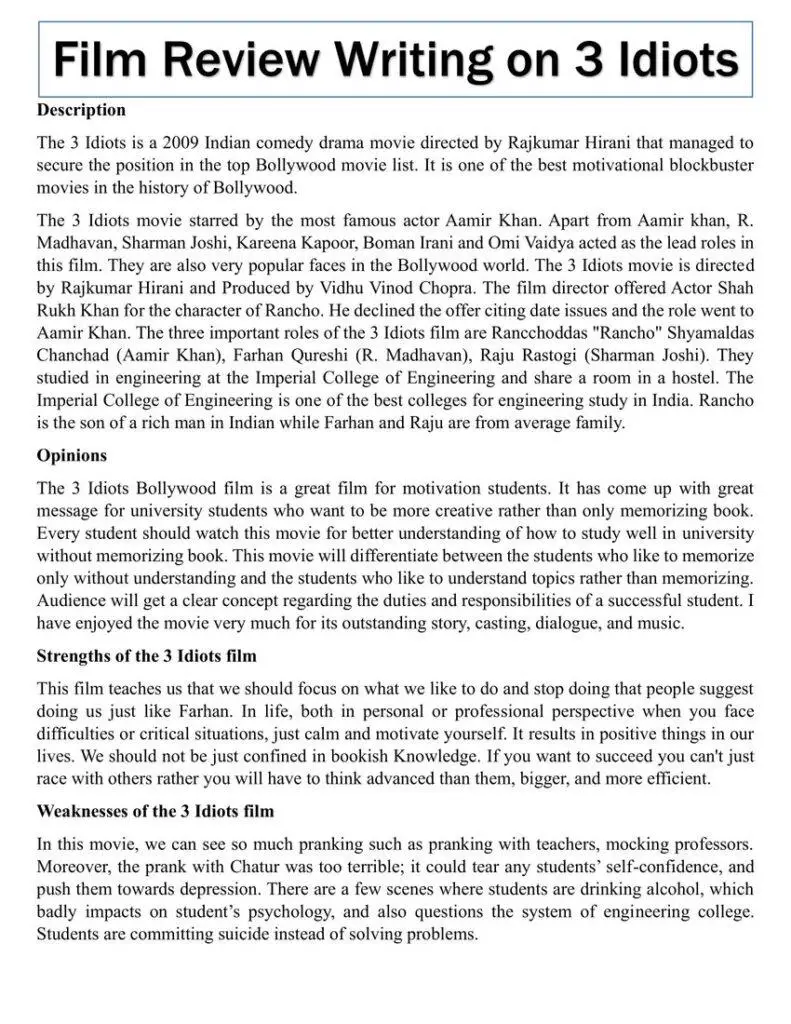 Conclusion
Conclusion
The seven steps to write a feature article are: select the topic, target audience, research the topic, outline the steps, start the writing process and propose recommendations and cautions, and edit and Proofread. People read feature articles to earn more knowledge on certain events. Sometimes, the audiences read feature writing to get instructions to complete their tasks. So, the writer should be more responsible when writing a feature article to educate the audience. Hopefully, the seven steps to writing a feature article will assist students in completing feature writing assignments. It also guides new writers and journalists in writing complete feature articles.
